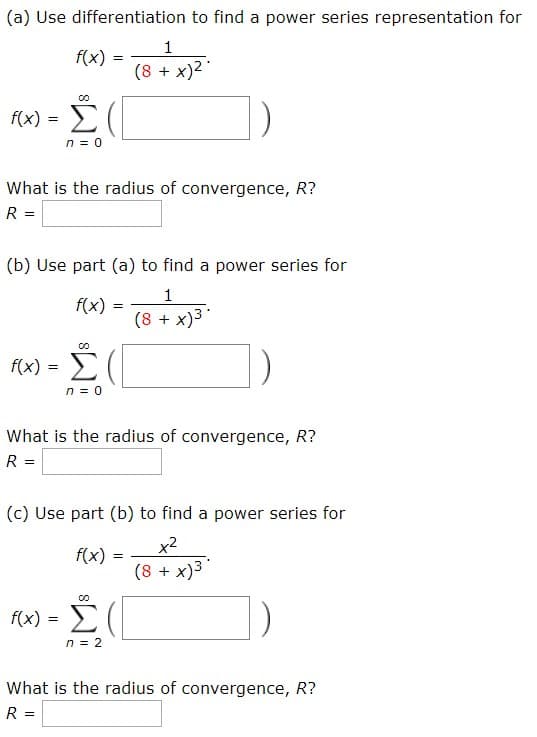(a) Use differentiation to find a power series representation for 1 f(x) (8 + x)2 f(x) = n = 0 Σ What is the radius of convergence, R? R = (b) Use part (a) to find a power series for 1 f(x) (8 + x)3 f(x) = n = 0 Σ What is the radius of convergence, R? R = (c) Use part (b) to find a power series for x2 f(x) (8 + x)3" Σ f(x) = n = 2 What is the radius of convergence, R? R =
(a) Use differentiation to find a power series representation for 1 f(x) (8 + x)2 f(x) = n = 0 Σ What is the radius of convergence, R? R = (b) Use part (a) to find a power series for 1 f(x) (8 + x)3 f(x) = n = 0 Σ What is the radius of convergence, R? R = (c) Use part (b) to find a power series for x2 f(x) (8 + x)3" Σ f(x) = n = 2 What is the radius of convergence, R? R =
Algebra & Trigonometry with Analytic Geometry
13th Edition
ISBN:9781133382119
Author:Swokowski
Publisher:Swokowski
Chapter10: Sequences, Series, And Probability
Section10.2: Arithmetic Sequences
Problem 67E
Related questions
Question

Transcribed Image Text:(a) Use differentiation to find a power series representation for
1
f(x)
(8 + x)2
f(x) = E (
n = 0
What is the radius of convergence, R?
R =
(b) Use part (a) to find
power series for
f(x)
(8 + x)3
f(x) = E(
n = 0
What is the radius of convergence, R?
R =
(c) Use part (b) to find a power series for
x2
(8 + x)3
f(x)
(x) = (
n = 2
What is the radius of convergence, R?
R =
Expert Solution
This question has been solved!
Explore an expertly crafted, step-by-step solution for a thorough understanding of key concepts.
This is a popular solution!
Trending now
This is a popular solution!
Step by step
Solved in 6 steps

Knowledge Booster
Learn more about
Need a deep-dive on the concept behind this application? Look no further. Learn more about this topic, advanced-math and related others by exploring similar questions and additional content below.Recommended textbooks for you

Algebra & Trigonometry with Analytic Geometry
Algebra
ISBN:
9781133382119
Author:
Swokowski
Publisher:
Cengage

Algebra & Trigonometry with Analytic Geometry
Algebra
ISBN:
9781133382119
Author:
Swokowski
Publisher:
Cengage